Critical Appraisal Essay: Antibiotic Treatment Effectiveness
VerifiedAdded on 2020/10/23
|11
|3428
|173
Essay
AI Summary
This critical appraisal essay examines the effects of antimicrobial treatments on hospitalized patients, focusing on antibiotic resistance. The essay utilizes the CASP checklist and NHMRC Body of Evidence matrix to analyze five peer-reviewed articles, including prospective and randomized controlled trial studies. The findings highlight the effectiveness of various treatments for conditions like pneumonia, with discussions on study methodologies (randomized controlled trials and cohort studies), patient selection, and the significance of treatment results. The analysis includes evaluations of factors such as the duration of antimicrobial therapy, the impact of penicillin-resistant strains, and the importance of patient outcomes. The essay provides a comprehensive overview of the research, assessing the clinical impact, consistency, and generalizability of the studies, offering insights into the current state of antibiotic treatment and its implications for healthcare practices and patient care.
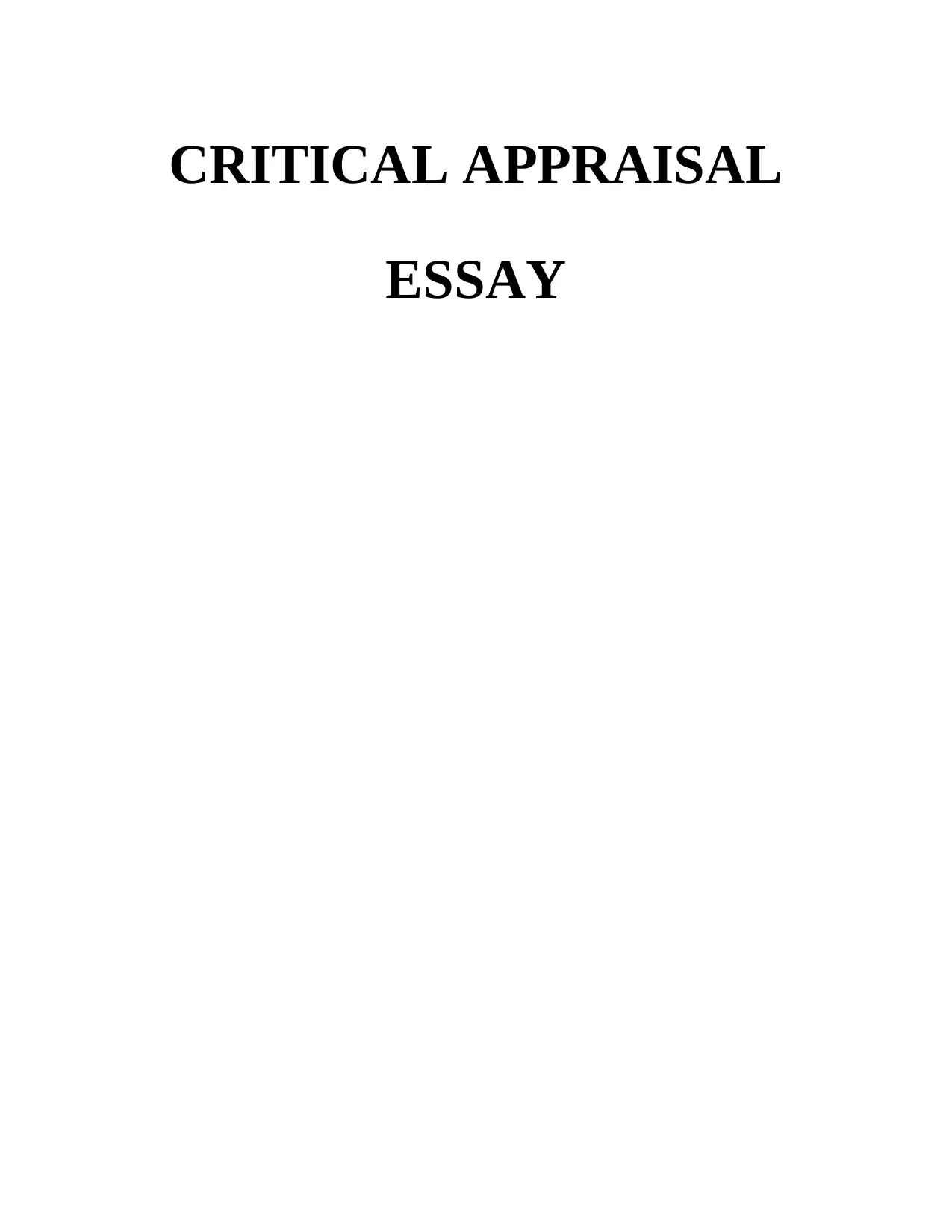
CRITICAL APPRAISAL
ESSAY
ESSAY
Paraphrase This Document
Need a fresh take? Get an instant paraphrase of this document with our AI Paraphraser
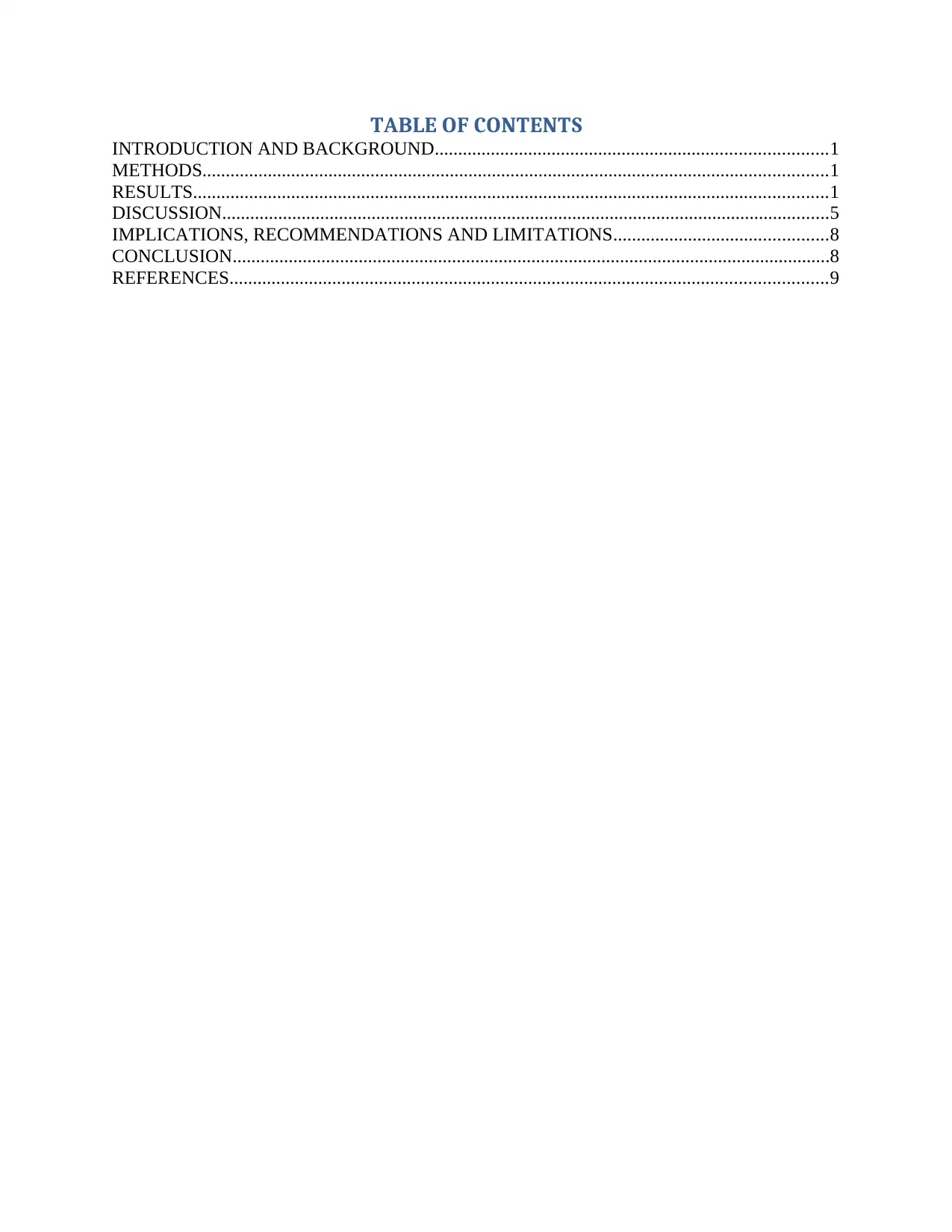
TABLE OF CONTENTS
INTRODUCTION AND BACKGROUND....................................................................................1
METHODS......................................................................................................................................1
RESULTS........................................................................................................................................1
DISCUSSION..................................................................................................................................5
IMPLICATIONS, RECOMMENDATIONS AND LIMITATIONS..............................................8
CONCLUSION................................................................................................................................8
REFERENCES................................................................................................................................9
INTRODUCTION AND BACKGROUND....................................................................................1
METHODS......................................................................................................................................1
RESULTS........................................................................................................................................1
DISCUSSION..................................................................................................................................5
IMPLICATIONS, RECOMMENDATIONS AND LIMITATIONS..............................................8
CONCLUSION................................................................................................................................8
REFERENCES................................................................................................................................9
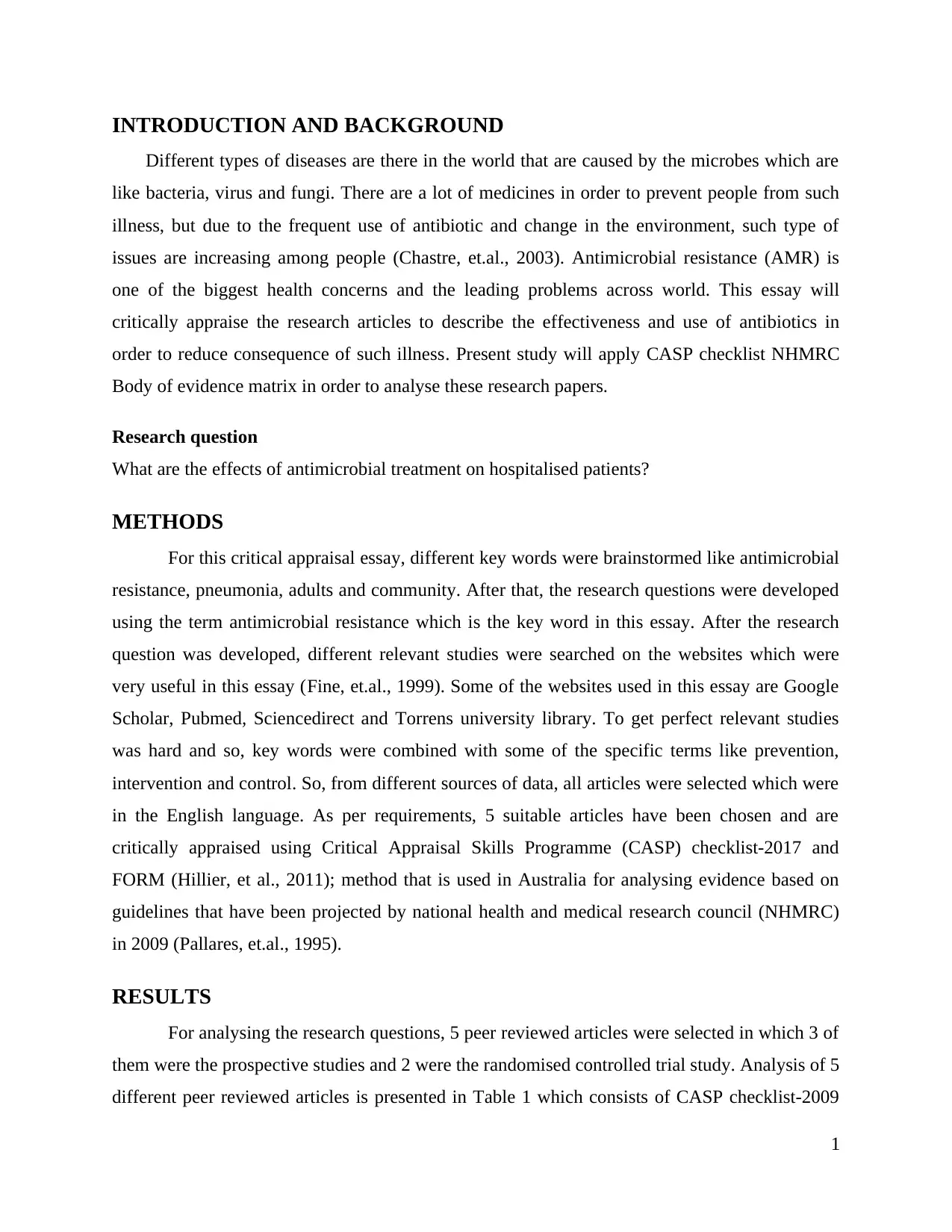
INTRODUCTION AND BACKGROUND
Different types of diseases are there in the world that are caused by the microbes which are
like bacteria, virus and fungi. There are a lot of medicines in order to prevent people from such
illness, but due to the frequent use of antibiotic and change in the environment, such type of
issues are increasing among people (Chastre, et.al., 2003). Antimicrobial resistance (AMR) is
one of the biggest health concerns and the leading problems across world. This essay will
critically appraise the research articles to describe the effectiveness and use of antibiotics in
order to reduce consequence of such illness. Present study will apply CASP checklist NHMRC
Body of evidence matrix in order to analyse these research papers.
Research question
What are the effects of antimicrobial treatment on hospitalised patients?
METHODS
For this critical appraisal essay, different key words were brainstormed like antimicrobial
resistance, pneumonia, adults and community. After that, the research questions were developed
using the term antimicrobial resistance which is the key word in this essay. After the research
question was developed, different relevant studies were searched on the websites which were
very useful in this essay (Fine, et.al., 1999). Some of the websites used in this essay are Google
Scholar, Pubmed, Sciencedirect and Torrens university library. To get perfect relevant studies
was hard and so, key words were combined with some of the specific terms like prevention,
intervention and control. So, from different sources of data, all articles were selected which were
in the English language. As per requirements, 5 suitable articles have been chosen and are
critically appraised using Critical Appraisal Skills Programme (CASP) checklist-2017 and
FORM (Hillier, et al., 2011); method that is used in Australia for analysing evidence based on
guidelines that have been projected by national health and medical research council (NHMRC)
in 2009 (Pallares, et.al., 1995).
RESULTS
For analysing the research questions, 5 peer reviewed articles were selected in which 3 of
them were the prospective studies and 2 were the randomised controlled trial study. Analysis of 5
different peer reviewed articles is presented in Table 1 which consists of CASP checklist-2009
1
Different types of diseases are there in the world that are caused by the microbes which are
like bacteria, virus and fungi. There are a lot of medicines in order to prevent people from such
illness, but due to the frequent use of antibiotic and change in the environment, such type of
issues are increasing among people (Chastre, et.al., 2003). Antimicrobial resistance (AMR) is
one of the biggest health concerns and the leading problems across world. This essay will
critically appraise the research articles to describe the effectiveness and use of antibiotics in
order to reduce consequence of such illness. Present study will apply CASP checklist NHMRC
Body of evidence matrix in order to analyse these research papers.
Research question
What are the effects of antimicrobial treatment on hospitalised patients?
METHODS
For this critical appraisal essay, different key words were brainstormed like antimicrobial
resistance, pneumonia, adults and community. After that, the research questions were developed
using the term antimicrobial resistance which is the key word in this essay. After the research
question was developed, different relevant studies were searched on the websites which were
very useful in this essay (Fine, et.al., 1999). Some of the websites used in this essay are Google
Scholar, Pubmed, Sciencedirect and Torrens university library. To get perfect relevant studies
was hard and so, key words were combined with some of the specific terms like prevention,
intervention and control. So, from different sources of data, all articles were selected which were
in the English language. As per requirements, 5 suitable articles have been chosen and are
critically appraised using Critical Appraisal Skills Programme (CASP) checklist-2017 and
FORM (Hillier, et al., 2011); method that is used in Australia for analysing evidence based on
guidelines that have been projected by national health and medical research council (NHMRC)
in 2009 (Pallares, et.al., 1995).
RESULTS
For analysing the research questions, 5 peer reviewed articles were selected in which 3 of
them were the prospective studies and 2 were the randomised controlled trial study. Analysis of 5
different peer reviewed articles is presented in Table 1 which consists of CASP checklist-2009
1
⊘ This is a preview!⊘
Do you want full access?
Subscribe today to unlock all pages.

Trusted by 1+ million students worldwide
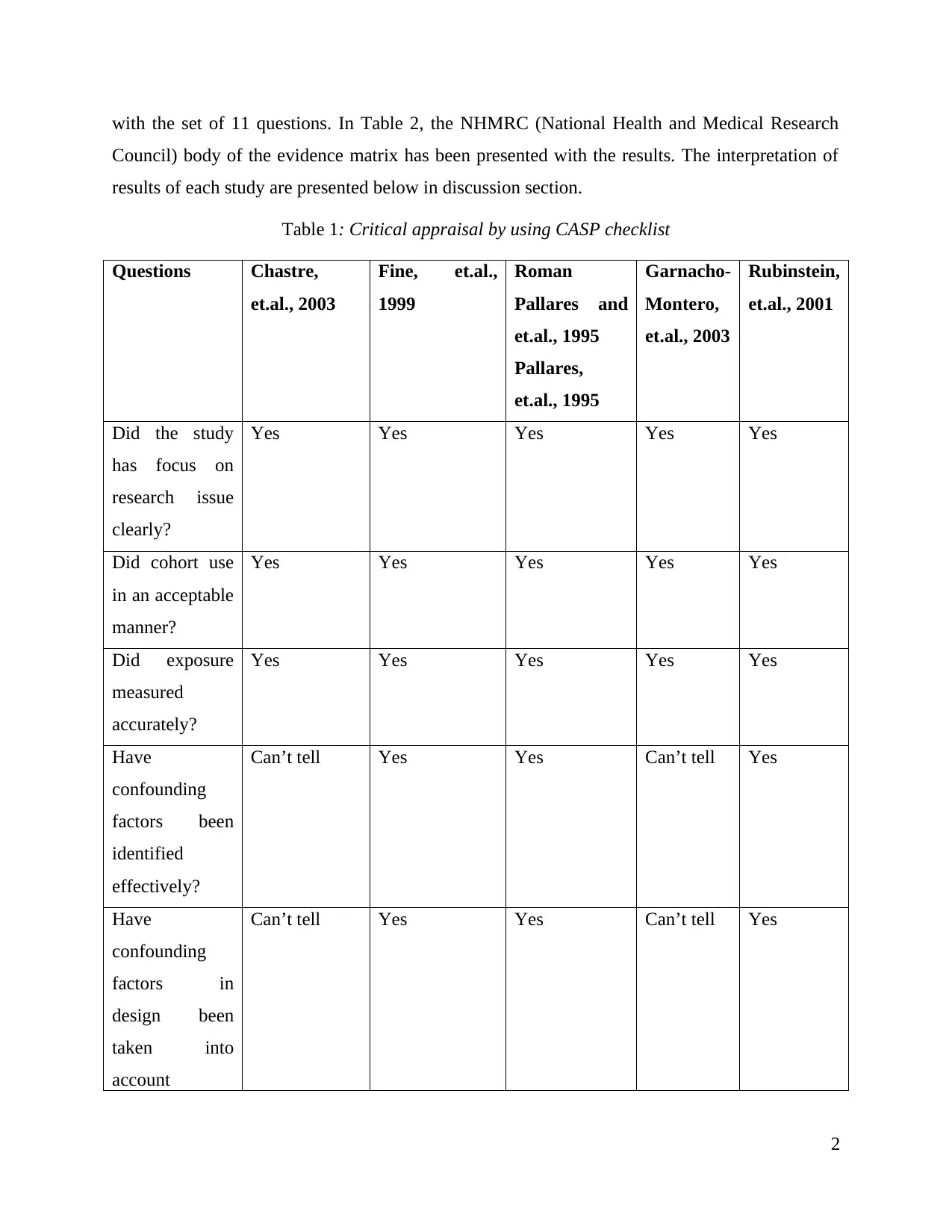
with the set of 11 questions. In Table 2, the NHMRC (National Health and Medical Research
Council) body of the evidence matrix has been presented with the results. The interpretation of
results of each study are presented below in discussion section.
Table 1: Critical appraisal by using CASP checklist
Questions Chastre,
et.al., 2003
Fine, et.al.,
1999
Roman
Pallares and
et.al., 1995
Pallares,
et.al., 1995
Garnacho-
Montero,
et.al., 2003
Rubinstein,
et.al., 2001
Did the study
has focus on
research issue
clearly?
Yes Yes Yes Yes Yes
Did cohort use
in an acceptable
manner?
Yes Yes Yes Yes Yes
Did exposure
measured
accurately?
Yes Yes Yes Yes Yes
Have
confounding
factors been
identified
effectively?
Can’t tell Yes Yes Can’t tell Yes
Have
confounding
factors in
design been
taken into
account
Can’t tell Yes Yes Can’t tell Yes
2
Council) body of the evidence matrix has been presented with the results. The interpretation of
results of each study are presented below in discussion section.
Table 1: Critical appraisal by using CASP checklist
Questions Chastre,
et.al., 2003
Fine, et.al.,
1999
Roman
Pallares and
et.al., 1995
Pallares,
et.al., 1995
Garnacho-
Montero,
et.al., 2003
Rubinstein,
et.al., 2001
Did the study
has focus on
research issue
clearly?
Yes Yes Yes Yes Yes
Did cohort use
in an acceptable
manner?
Yes Yes Yes Yes Yes
Did exposure
measured
accurately?
Yes Yes Yes Yes Yes
Have
confounding
factors been
identified
effectively?
Can’t tell Yes Yes Can’t tell Yes
Have
confounding
factors in
design been
taken into
account
Can’t tell Yes Yes Can’t tell Yes
2
Paraphrase This Document
Need a fresh take? Get an instant paraphrase of this document with our AI Paraphraser
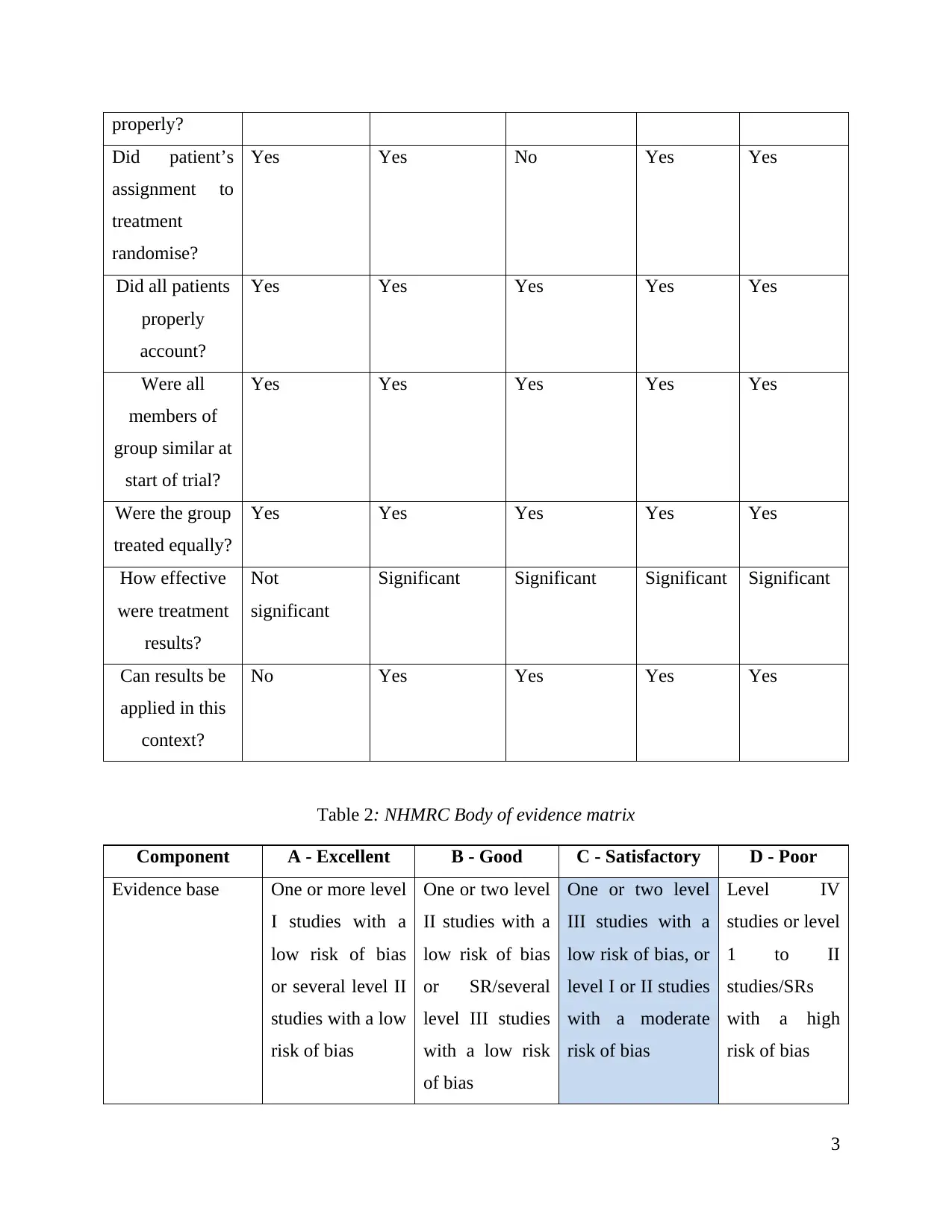
properly?
Did patient’s
assignment to
treatment
randomise?
Yes Yes No Yes Yes
Did all patients
properly
account?
Yes Yes Yes Yes Yes
Were all
members of
group similar at
start of trial?
Yes Yes Yes Yes Yes
Were the group
treated equally?
Yes Yes Yes Yes Yes
How effective
were treatment
results?
Not
significant
Significant Significant Significant Significant
Can results be
applied in this
context?
No Yes Yes Yes Yes
Table 2: NHMRC Body of evidence matrix
Component A - Excellent B - Good C - Satisfactory D - Poor
Evidence base One or more level
I studies with a
low risk of bias
or several level II
studies with a low
risk of bias
One or two level
II studies with a
low risk of bias
or SR/several
level III studies
with a low risk
of bias
One or two level
III studies with a
low risk of bias, or
level I or II studies
with a moderate
risk of bias
Level IV
studies or level
1 to II
studies/SRs
with a high
risk of bias
3
Did patient’s
assignment to
treatment
randomise?
Yes Yes No Yes Yes
Did all patients
properly
account?
Yes Yes Yes Yes Yes
Were all
members of
group similar at
start of trial?
Yes Yes Yes Yes Yes
Were the group
treated equally?
Yes Yes Yes Yes Yes
How effective
were treatment
results?
Not
significant
Significant Significant Significant Significant
Can results be
applied in this
context?
No Yes Yes Yes Yes
Table 2: NHMRC Body of evidence matrix
Component A - Excellent B - Good C - Satisfactory D - Poor
Evidence base One or more level
I studies with a
low risk of bias
or several level II
studies with a low
risk of bias
One or two level
II studies with a
low risk of bias
or SR/several
level III studies
with a low risk
of bias
One or two level
III studies with a
low risk of bias, or
level I or II studies
with a moderate
risk of bias
Level IV
studies or level
1 to II
studies/SRs
with a high
risk of bias
3
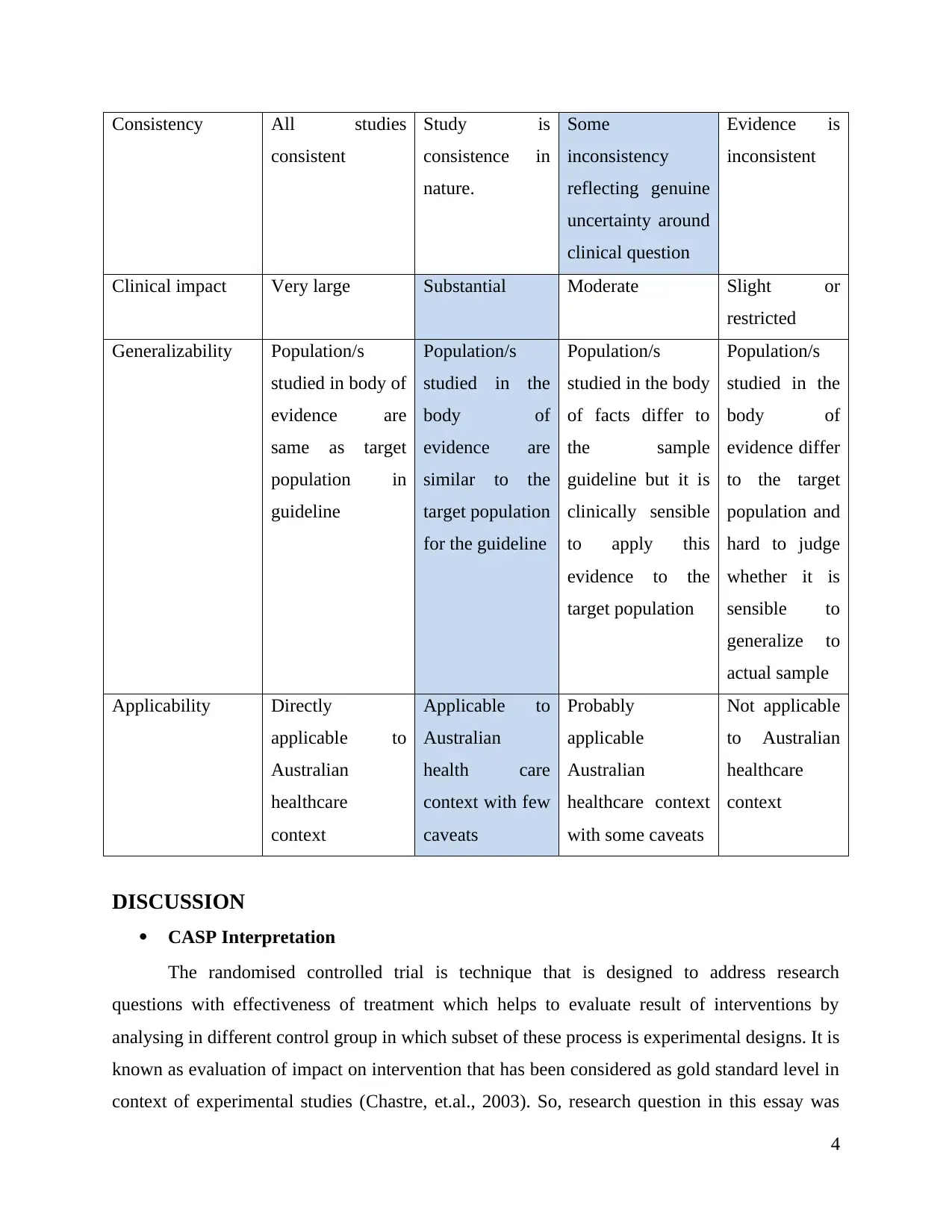
Consistency All studies
consistent
Study is
consistence in
nature.
Some
inconsistency
reflecting genuine
uncertainty around
clinical question
Evidence is
inconsistent
Clinical impact Very large Substantial Moderate Slight or
restricted
Generalizability Population/s
studied in body of
evidence are
same as target
population in
guideline
Population/s
studied in the
body of
evidence are
similar to the
target population
for the guideline
Population/s
studied in the body
of facts differ to
the sample
guideline but it is
clinically sensible
to apply this
evidence to the
target population
Population/s
studied in the
body of
evidence differ
to the target
population and
hard to judge
whether it is
sensible to
generalize to
actual sample
Applicability Directly
applicable to
Australian
healthcare
context
Applicable to
Australian
health care
context with few
caveats
Probably
applicable
Australian
healthcare context
with some caveats
Not applicable
to Australian
healthcare
context
DISCUSSION
CASP Interpretation
The randomised controlled trial is technique that is designed to address research
questions with effectiveness of treatment which helps to evaluate result of interventions by
analysing in different control group in which subset of these process is experimental designs. It is
known as evaluation of impact on intervention that has been considered as gold standard level in
context of experimental studies (Chastre, et.al., 2003). So, research question in this essay was
4
consistent
Study is
consistence in
nature.
Some
inconsistency
reflecting genuine
uncertainty around
clinical question
Evidence is
inconsistent
Clinical impact Very large Substantial Moderate Slight or
restricted
Generalizability Population/s
studied in body of
evidence are
same as target
population in
guideline
Population/s
studied in the
body of
evidence are
similar to the
target population
for the guideline
Population/s
studied in the body
of facts differ to
the sample
guideline but it is
clinically sensible
to apply this
evidence to the
target population
Population/s
studied in the
body of
evidence differ
to the target
population and
hard to judge
whether it is
sensible to
generalize to
actual sample
Applicability Directly
applicable to
Australian
healthcare
context
Applicable to
Australian
health care
context with few
caveats
Probably
applicable
Australian
healthcare context
with some caveats
Not applicable
to Australian
healthcare
context
DISCUSSION
CASP Interpretation
The randomised controlled trial is technique that is designed to address research
questions with effectiveness of treatment which helps to evaluate result of interventions by
analysing in different control group in which subset of these process is experimental designs. It is
known as evaluation of impact on intervention that has been considered as gold standard level in
context of experimental studies (Chastre, et.al., 2003). So, research question in this essay was
4
⊘ This is a preview!⊘
Do you want full access?
Subscribe today to unlock all pages.

Trusted by 1+ million students worldwide
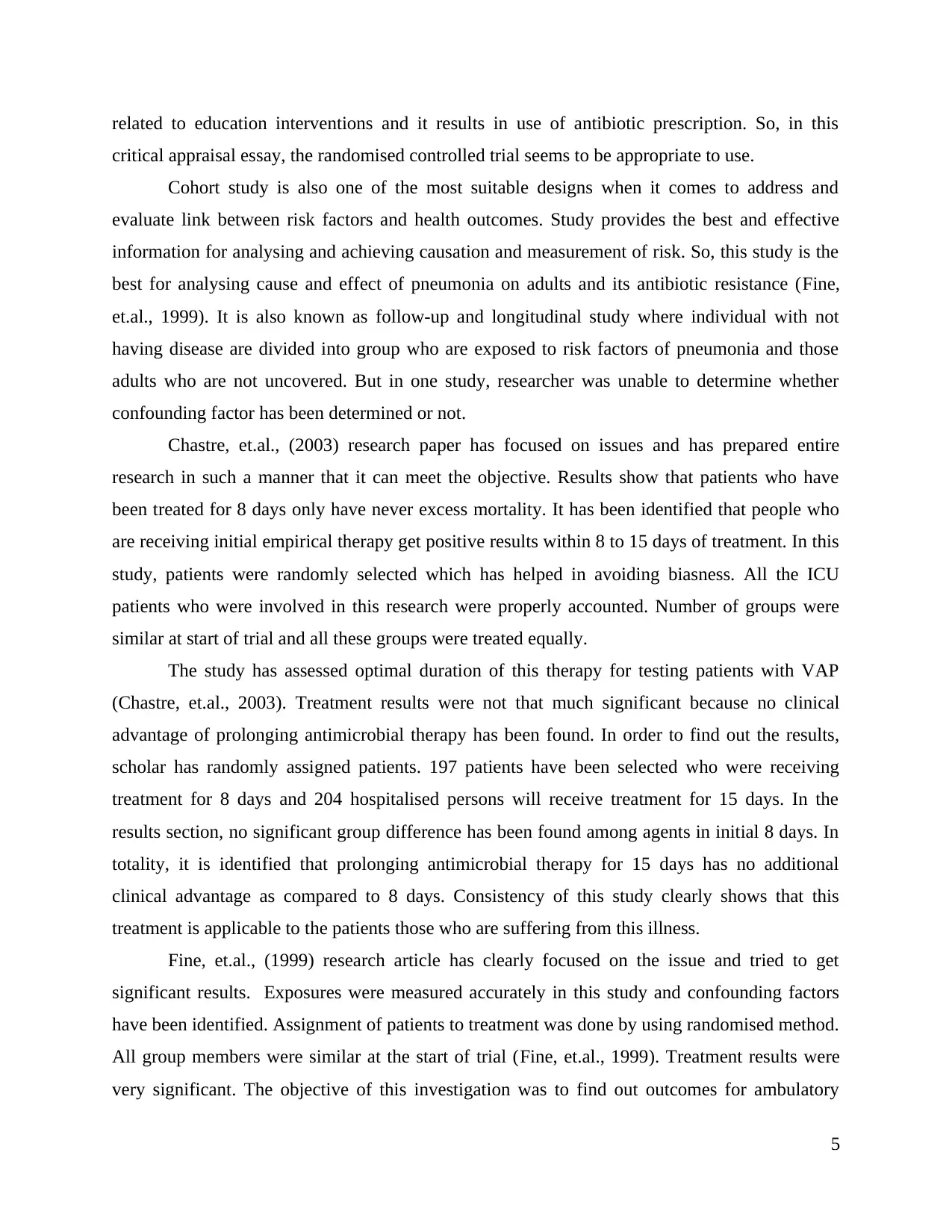
related to education interventions and it results in use of antibiotic prescription. So, in this
critical appraisal essay, the randomised controlled trial seems to be appropriate to use.
Cohort study is also one of the most suitable designs when it comes to address and
evaluate link between risk factors and health outcomes. Study provides the best and effective
information for analysing and achieving causation and measurement of risk. So, this study is the
best for analysing cause and effect of pneumonia on adults and its antibiotic resistance (Fine,
et.al., 1999). It is also known as follow-up and longitudinal study where individual with not
having disease are divided into group who are exposed to risk factors of pneumonia and those
adults who are not uncovered. But in one study, researcher was unable to determine whether
confounding factor has been determined or not.
Chastre, et.al., (2003) research paper has focused on issues and has prepared entire
research in such a manner that it can meet the objective. Results show that patients who have
been treated for 8 days only have never excess mortality. It has been identified that people who
are receiving initial empirical therapy get positive results within 8 to 15 days of treatment. In this
study, patients were randomly selected which has helped in avoiding biasness. All the ICU
patients who were involved in this research were properly accounted. Number of groups were
similar at start of trial and all these groups were treated equally.
The study has assessed optimal duration of this therapy for testing patients with VAP
(Chastre, et.al., 2003). Treatment results were not that much significant because no clinical
advantage of prolonging antimicrobial therapy has been found. In order to find out the results,
scholar has randomly assigned patients. 197 patients have been selected who were receiving
treatment for 8 days and 204 hospitalised persons will receive treatment for 15 days. In the
results section, no significant group difference has been found among agents in initial 8 days. In
totality, it is identified that prolonging antimicrobial therapy for 15 days has no additional
clinical advantage as compared to 8 days. Consistency of this study clearly shows that this
treatment is applicable to the patients those who are suffering from this illness.
Fine, et.al., (1999) research article has clearly focused on the issue and tried to get
significant results. Exposures were measured accurately in this study and confounding factors
have been identified. Assignment of patients to treatment was done by using randomised method.
All group members were similar at the start of trial (Fine, et.al., 1999). Treatment results were
very significant. The objective of this investigation was to find out outcomes for ambulatory
5
critical appraisal essay, the randomised controlled trial seems to be appropriate to use.
Cohort study is also one of the most suitable designs when it comes to address and
evaluate link between risk factors and health outcomes. Study provides the best and effective
information for analysing and achieving causation and measurement of risk. So, this study is the
best for analysing cause and effect of pneumonia on adults and its antibiotic resistance (Fine,
et.al., 1999). It is also known as follow-up and longitudinal study where individual with not
having disease are divided into group who are exposed to risk factors of pneumonia and those
adults who are not uncovered. But in one study, researcher was unable to determine whether
confounding factor has been determined or not.
Chastre, et.al., (2003) research paper has focused on issues and has prepared entire
research in such a manner that it can meet the objective. Results show that patients who have
been treated for 8 days only have never excess mortality. It has been identified that people who
are receiving initial empirical therapy get positive results within 8 to 15 days of treatment. In this
study, patients were randomly selected which has helped in avoiding biasness. All the ICU
patients who were involved in this research were properly accounted. Number of groups were
similar at start of trial and all these groups were treated equally.
The study has assessed optimal duration of this therapy for testing patients with VAP
(Chastre, et.al., 2003). Treatment results were not that much significant because no clinical
advantage of prolonging antimicrobial therapy has been found. In order to find out the results,
scholar has randomly assigned patients. 197 patients have been selected who were receiving
treatment for 8 days and 204 hospitalised persons will receive treatment for 15 days. In the
results section, no significant group difference has been found among agents in initial 8 days. In
totality, it is identified that prolonging antimicrobial therapy for 15 days has no additional
clinical advantage as compared to 8 days. Consistency of this study clearly shows that this
treatment is applicable to the patients those who are suffering from this illness.
Fine, et.al., (1999) research article has clearly focused on the issue and tried to get
significant results. Exposures were measured accurately in this study and confounding factors
have been identified. Assignment of patients to treatment was done by using randomised method.
All group members were similar at the start of trial (Fine, et.al., 1999). Treatment results were
very significant. The objective of this investigation was to find out outcomes for ambulatory
5
Paraphrase This Document
Need a fresh take? Get an instant paraphrase of this document with our AI Paraphraser
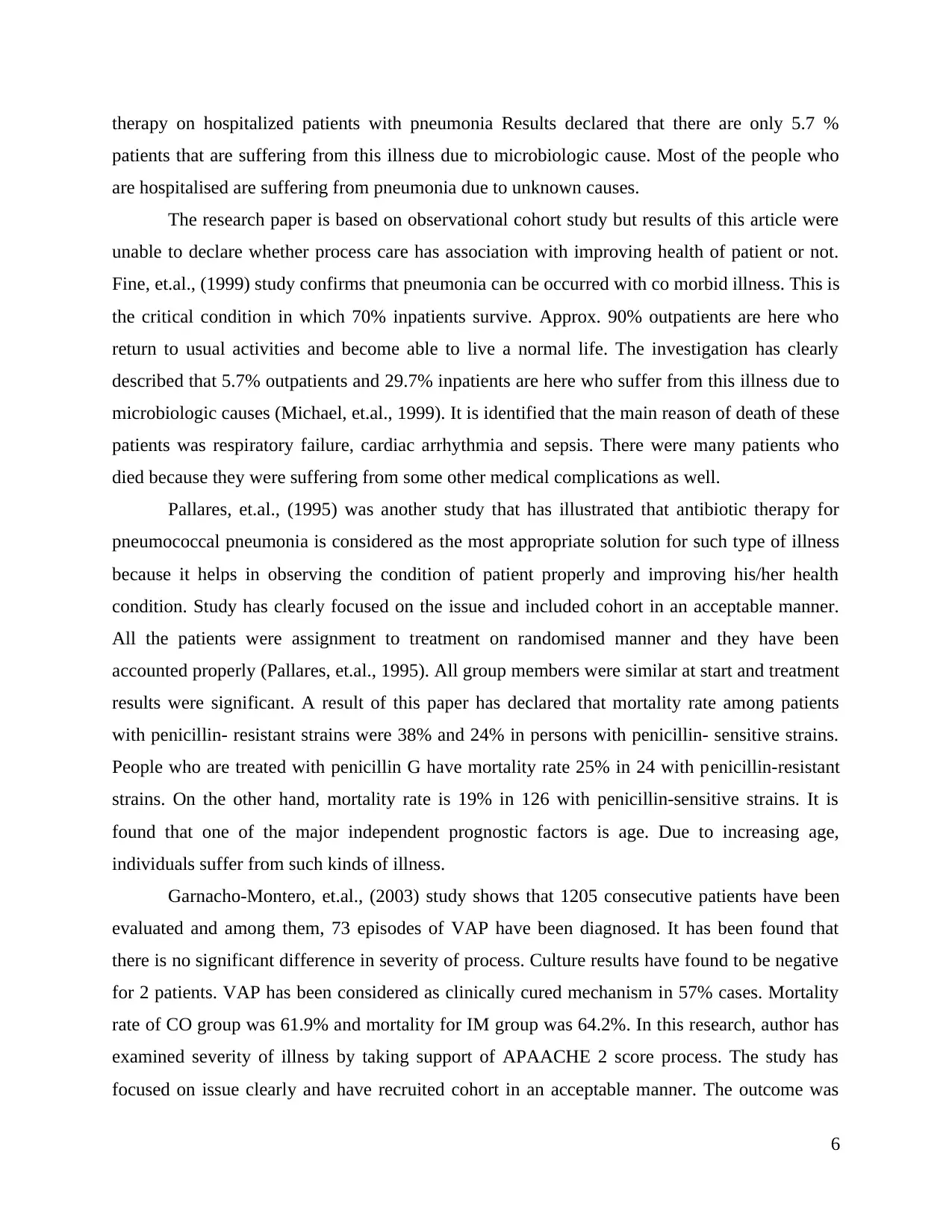
therapy on hospitalized patients with pneumonia Results declared that there are only 5.7 %
patients that are suffering from this illness due to microbiologic cause. Most of the people who
are hospitalised are suffering from pneumonia due to unknown causes.
The research paper is based on observational cohort study but results of this article were
unable to declare whether process care has association with improving health of patient or not.
Fine, et.al., (1999) study confirms that pneumonia can be occurred with co morbid illness. This is
the critical condition in which 70% inpatients survive. Approx. 90% outpatients are here who
return to usual activities and become able to live a normal life. The investigation has clearly
described that 5.7% outpatients and 29.7% inpatients are here who suffer from this illness due to
microbiologic causes (Michael, et.al., 1999). It is identified that the main reason of death of these
patients was respiratory failure, cardiac arrhythmia and sepsis. There were many patients who
died because they were suffering from some other medical complications as well.
Pallares, et.al., (1995) was another study that has illustrated that antibiotic therapy for
pneumococcal pneumonia is considered as the most appropriate solution for such type of illness
because it helps in observing the condition of patient properly and improving his/her health
condition. Study has clearly focused on the issue and included cohort in an acceptable manner.
All the patients were assignment to treatment on randomised manner and they have been
accounted properly (Pallares, et.al., 1995). All group members were similar at start and treatment
results were significant. A result of this paper has declared that mortality rate among patients
with penicillin- resistant strains were 38% and 24% in persons with penicillin- sensitive strains.
People who are treated with penicillin G have mortality rate 25% in 24 with penicillin-resistant
strains. On the other hand, mortality rate is 19% in 126 with penicillin-sensitive strains. It is
found that one of the major independent prognostic factors is age. Due to increasing age,
individuals suffer from such kinds of illness.
Garnacho-Montero, et.al., (2003) study shows that 1205 consecutive patients have been
evaluated and among them, 73 episodes of VAP have been diagnosed. It has been found that
there is no significant difference in severity of process. Culture results have found to be negative
for 2 patients. VAP has been considered as clinically cured mechanism in 57% cases. Mortality
rate of CO group was 61.9% and mortality for IM group was 64.2%. In this research, author has
examined severity of illness by taking support of APAACHE 2 score process. The study has
focused on issue clearly and have recruited cohort in an acceptable manner. The outcome was
6
patients that are suffering from this illness due to microbiologic cause. Most of the people who
are hospitalised are suffering from pneumonia due to unknown causes.
The research paper is based on observational cohort study but results of this article were
unable to declare whether process care has association with improving health of patient or not.
Fine, et.al., (1999) study confirms that pneumonia can be occurred with co morbid illness. This is
the critical condition in which 70% inpatients survive. Approx. 90% outpatients are here who
return to usual activities and become able to live a normal life. The investigation has clearly
described that 5.7% outpatients and 29.7% inpatients are here who suffer from this illness due to
microbiologic causes (Michael, et.al., 1999). It is identified that the main reason of death of these
patients was respiratory failure, cardiac arrhythmia and sepsis. There were many patients who
died because they were suffering from some other medical complications as well.
Pallares, et.al., (1995) was another study that has illustrated that antibiotic therapy for
pneumococcal pneumonia is considered as the most appropriate solution for such type of illness
because it helps in observing the condition of patient properly and improving his/her health
condition. Study has clearly focused on the issue and included cohort in an acceptable manner.
All the patients were assignment to treatment on randomised manner and they have been
accounted properly (Pallares, et.al., 1995). All group members were similar at start and treatment
results were significant. A result of this paper has declared that mortality rate among patients
with penicillin- resistant strains were 38% and 24% in persons with penicillin- sensitive strains.
People who are treated with penicillin G have mortality rate 25% in 24 with penicillin-resistant
strains. On the other hand, mortality rate is 19% in 126 with penicillin-sensitive strains. It is
found that one of the major independent prognostic factors is age. Due to increasing age,
individuals suffer from such kinds of illness.
Garnacho-Montero, et.al., (2003) study shows that 1205 consecutive patients have been
evaluated and among them, 73 episodes of VAP have been diagnosed. It has been found that
there is no significant difference in severity of process. Culture results have found to be negative
for 2 patients. VAP has been considered as clinically cured mechanism in 57% cases. Mortality
rate of CO group was 61.9% and mortality for IM group was 64.2%. In this research, author has
examined severity of illness by taking support of APAACHE 2 score process. The study has
focused on issue clearly and have recruited cohort in an acceptable manner. The outcome was
6
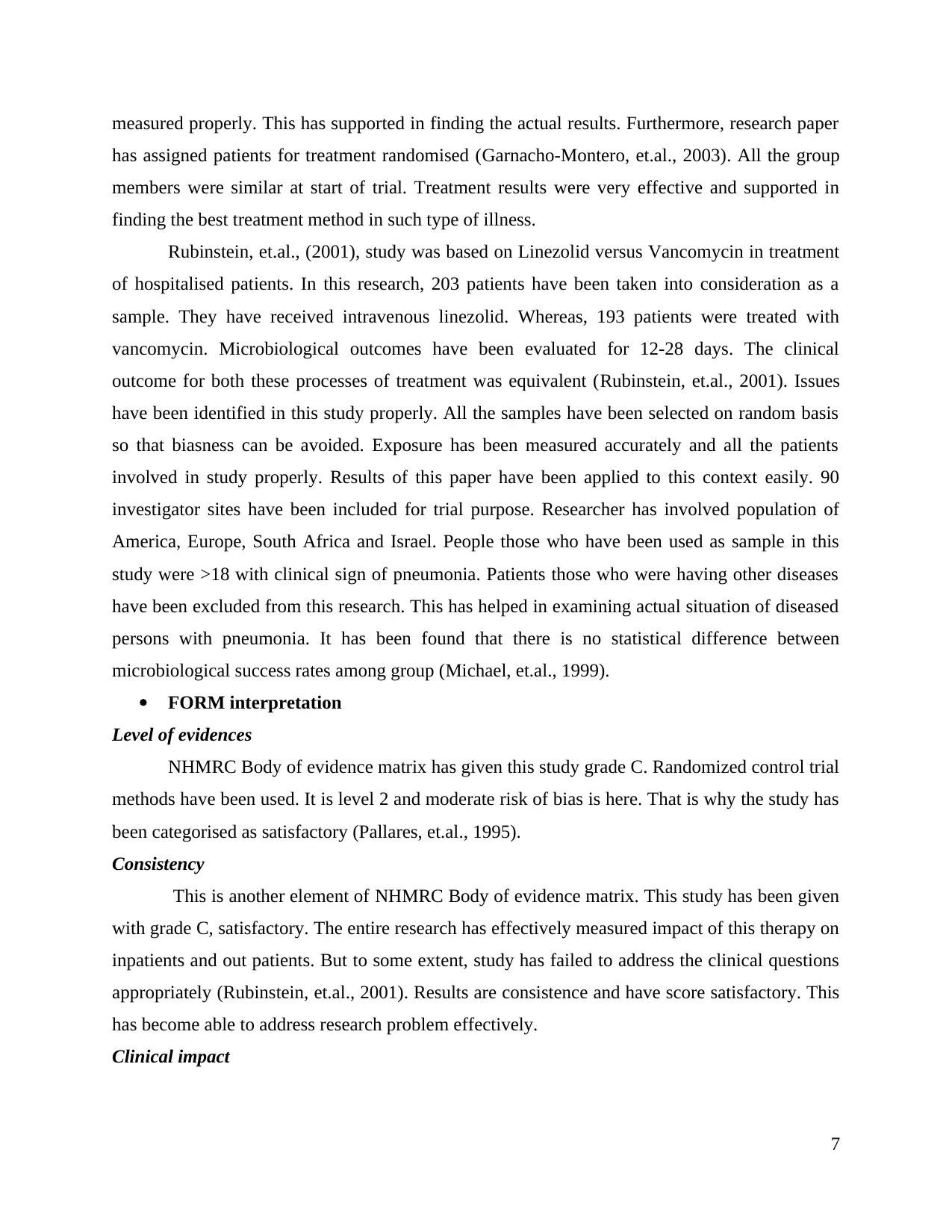
measured properly. This has supported in finding the actual results. Furthermore, research paper
has assigned patients for treatment randomised (Garnacho-Montero, et.al., 2003). All the group
members were similar at start of trial. Treatment results were very effective and supported in
finding the best treatment method in such type of illness.
Rubinstein, et.al., (2001), study was based on Linezolid versus Vancomycin in treatment
of hospitalised patients. In this research, 203 patients have been taken into consideration as a
sample. They have received intravenous linezolid. Whereas, 193 patients were treated with
vancomycin. Microbiological outcomes have been evaluated for 12-28 days. The clinical
outcome for both these processes of treatment was equivalent (Rubinstein, et.al., 2001). Issues
have been identified in this study properly. All the samples have been selected on random basis
so that biasness can be avoided. Exposure has been measured accurately and all the patients
involved in study properly. Results of this paper have been applied to this context easily. 90
investigator sites have been included for trial purpose. Researcher has involved population of
America, Europe, South Africa and Israel. People those who have been used as sample in this
study were >18 with clinical sign of pneumonia. Patients those who were having other diseases
have been excluded from this research. This has helped in examining actual situation of diseased
persons with pneumonia. It has been found that there is no statistical difference between
microbiological success rates among group (Michael, et.al., 1999).
FORM interpretation
Level of evidences
NHMRC Body of evidence matrix has given this study grade C. Randomized control trial
methods have been used. It is level 2 and moderate risk of bias is here. That is why the study has
been categorised as satisfactory (Pallares, et.al., 1995).
Consistency
This is another element of NHMRC Body of evidence matrix. This study has been given
with grade C, satisfactory. The entire research has effectively measured impact of this therapy on
inpatients and out patients. But to some extent, study has failed to address the clinical questions
appropriately (Rubinstein, et.al., 2001). Results are consistence and have score satisfactory. This
has become able to address research problem effectively.
Clinical impact
7
has assigned patients for treatment randomised (Garnacho-Montero, et.al., 2003). All the group
members were similar at start of trial. Treatment results were very effective and supported in
finding the best treatment method in such type of illness.
Rubinstein, et.al., (2001), study was based on Linezolid versus Vancomycin in treatment
of hospitalised patients. In this research, 203 patients have been taken into consideration as a
sample. They have received intravenous linezolid. Whereas, 193 patients were treated with
vancomycin. Microbiological outcomes have been evaluated for 12-28 days. The clinical
outcome for both these processes of treatment was equivalent (Rubinstein, et.al., 2001). Issues
have been identified in this study properly. All the samples have been selected on random basis
so that biasness can be avoided. Exposure has been measured accurately and all the patients
involved in study properly. Results of this paper have been applied to this context easily. 90
investigator sites have been included for trial purpose. Researcher has involved population of
America, Europe, South Africa and Israel. People those who have been used as sample in this
study were >18 with clinical sign of pneumonia. Patients those who were having other diseases
have been excluded from this research. This has helped in examining actual situation of diseased
persons with pneumonia. It has been found that there is no statistical difference between
microbiological success rates among group (Michael, et.al., 1999).
FORM interpretation
Level of evidences
NHMRC Body of evidence matrix has given this study grade C. Randomized control trial
methods have been used. It is level 2 and moderate risk of bias is here. That is why the study has
been categorised as satisfactory (Pallares, et.al., 1995).
Consistency
This is another element of NHMRC Body of evidence matrix. This study has been given
with grade C, satisfactory. The entire research has effectively measured impact of this therapy on
inpatients and out patients. But to some extent, study has failed to address the clinical questions
appropriately (Rubinstein, et.al., 2001). Results are consistence and have score satisfactory. This
has become able to address research problem effectively.
Clinical impact
7
⊘ This is a preview!⊘
Do you want full access?
Subscribe today to unlock all pages.

Trusted by 1+ million students worldwide
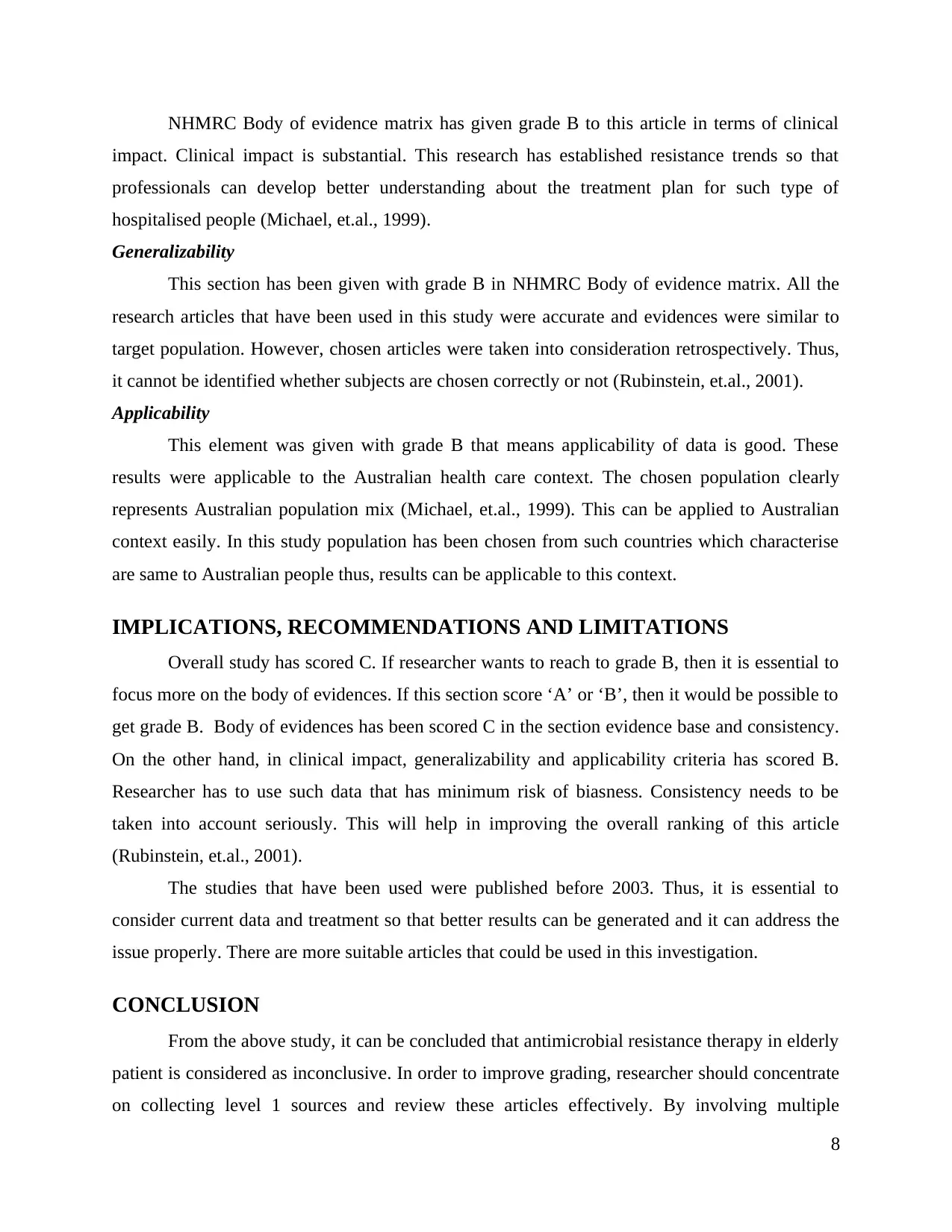
NHMRC Body of evidence matrix has given grade B to this article in terms of clinical
impact. Clinical impact is substantial. This research has established resistance trends so that
professionals can develop better understanding about the treatment plan for such type of
hospitalised people (Michael, et.al., 1999).
Generalizability
This section has been given with grade B in NHMRC Body of evidence matrix. All the
research articles that have been used in this study were accurate and evidences were similar to
target population. However, chosen articles were taken into consideration retrospectively. Thus,
it cannot be identified whether subjects are chosen correctly or not (Rubinstein, et.al., 2001).
Applicability
This element was given with grade B that means applicability of data is good. These
results were applicable to the Australian health care context. The chosen population clearly
represents Australian population mix (Michael, et.al., 1999). This can be applied to Australian
context easily. In this study population has been chosen from such countries which characterise
are same to Australian people thus, results can be applicable to this context.
IMPLICATIONS, RECOMMENDATIONS AND LIMITATIONS
Overall study has scored C. If researcher wants to reach to grade B, then it is essential to
focus more on the body of evidences. If this section score ‘A’ or ‘B’, then it would be possible to
get grade B. Body of evidences has been scored C in the section evidence base and consistency.
On the other hand, in clinical impact, generalizability and applicability criteria has scored B.
Researcher has to use such data that has minimum risk of biasness. Consistency needs to be
taken into account seriously. This will help in improving the overall ranking of this article
(Rubinstein, et.al., 2001).
The studies that have been used were published before 2003. Thus, it is essential to
consider current data and treatment so that better results can be generated and it can address the
issue properly. There are more suitable articles that could be used in this investigation.
CONCLUSION
From the above study, it can be concluded that antimicrobial resistance therapy in elderly
patient is considered as inconclusive. In order to improve grading, researcher should concentrate
on collecting level 1 sources and review these articles effectively. By involving multiple
8
impact. Clinical impact is substantial. This research has established resistance trends so that
professionals can develop better understanding about the treatment plan for such type of
hospitalised people (Michael, et.al., 1999).
Generalizability
This section has been given with grade B in NHMRC Body of evidence matrix. All the
research articles that have been used in this study were accurate and evidences were similar to
target population. However, chosen articles were taken into consideration retrospectively. Thus,
it cannot be identified whether subjects are chosen correctly or not (Rubinstein, et.al., 2001).
Applicability
This element was given with grade B that means applicability of data is good. These
results were applicable to the Australian health care context. The chosen population clearly
represents Australian population mix (Michael, et.al., 1999). This can be applied to Australian
context easily. In this study population has been chosen from such countries which characterise
are same to Australian people thus, results can be applicable to this context.
IMPLICATIONS, RECOMMENDATIONS AND LIMITATIONS
Overall study has scored C. If researcher wants to reach to grade B, then it is essential to
focus more on the body of evidences. If this section score ‘A’ or ‘B’, then it would be possible to
get grade B. Body of evidences has been scored C in the section evidence base and consistency.
On the other hand, in clinical impact, generalizability and applicability criteria has scored B.
Researcher has to use such data that has minimum risk of biasness. Consistency needs to be
taken into account seriously. This will help in improving the overall ranking of this article
(Rubinstein, et.al., 2001).
The studies that have been used were published before 2003. Thus, it is essential to
consider current data and treatment so that better results can be generated and it can address the
issue properly. There are more suitable articles that could be used in this investigation.
CONCLUSION
From the above study, it can be concluded that antimicrobial resistance therapy in elderly
patient is considered as inconclusive. In order to improve grading, researcher should concentrate
on collecting level 1 sources and review these articles effectively. By involving multiple
8
Paraphrase This Document
Need a fresh take? Get an instant paraphrase of this document with our AI Paraphraser

database, researcher would have option to minimise biasness and critically appraise these data in
the future.
9
the future.
9
1 out of 11
Related Documents
Your All-in-One AI-Powered Toolkit for Academic Success.
+13062052269
info@desklib.com
Available 24*7 on WhatsApp / Email
![[object Object]](/_next/static/media/star-bottom.7253800d.svg)
Unlock your academic potential
Copyright © 2020–2025 A2Z Services. All Rights Reserved. Developed and managed by ZUCOL.





